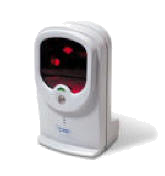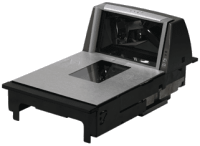 Hand Held Contact Scanners
Hand Held Contact ScannersHand Held contact scanners are very low cost, low power consumption devices suitable for relatively low volume applications.
These devices use LEDs to provide the light output, and usually must come in physical contact with the barcode to perform a read. Many of these scanners have a trigger that must be pressed to perform a read, though others can sense when they come close to an object, and turn on the LED's automatically.
There are a few very low cost models from unknown manufacturers, that have very poor read capability. If considering this type of scanner, it is a good idea to test the device to ensure that it does read properly. Most are very good, but there are a few that make life difficult due to bad read rates.
 Hand Held Laser Scanners
Hand Held Laser ScannersHandheld laser scanners do not need to come into physical contact with the barcode, and can read labels at distances ranging from a few inches to several feet.
When the trigger is pressed, a red line of laser light is emitted, and this needs to be pointed so that it crosses the width of the barcode.
These scanners are low in cost, and are particularly useful when you need to read barcodes on heavy items in a shopping cart, and presentation of the device to the scanner might be difficult.
 Presentation Scanners
Presentation ScannersPresentation scanners offer a big advantage because they offer hands free operation. These scanners can range from low cost units to very expensive models. These scanners require that the barcode be presented to the scanner, or passed in front.
Vertically mounted scanners such as this one, are usually better than horizontally mounted scanners where dirt can collect on the glass, requiring more frequent cleaning, and the risk of scratching the glass is greater.
 Built in Scanners
Built in ScannersCombination devices such as this Magellan 8200 Scanner and Scale offer the highest quality and performance however they need to be built into the checkout lane by shopfitters, and the flat metal top would be level with the top of the counter.
This particular device has a rotating prism inside, which reflects the laser light in many directions so that virtually any barcode can be scanned from any angle. The laser light is emitted from both the base of the unit as well as the side making it even easier to get a good read.
In addition, this device is an electronic scale. Items to be weighed are placed on top of the unit, and prepackaged item passed over it.
In high volume applications such as supermarkets these device are excellent. But of course, the shopfitter will probably charge more to install this type of device than the entire cost of a CCD handheld scanner...